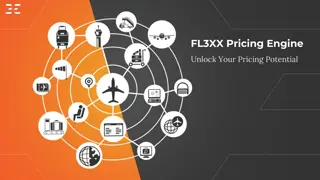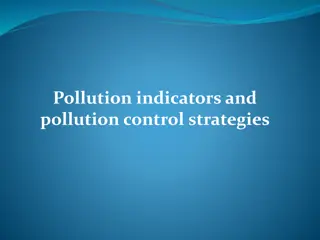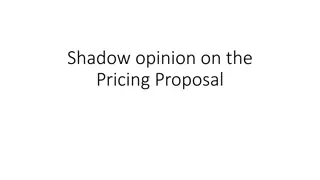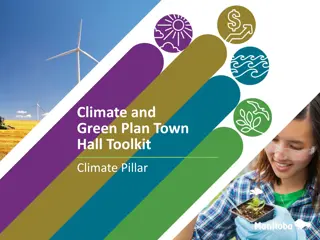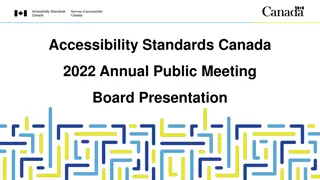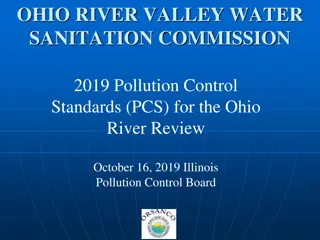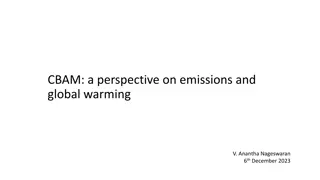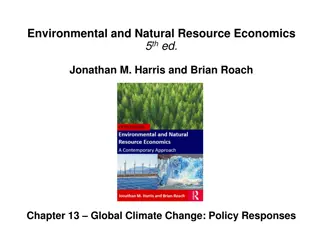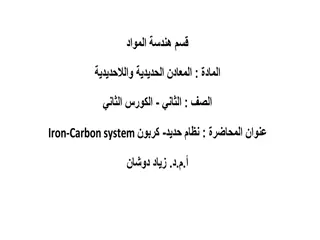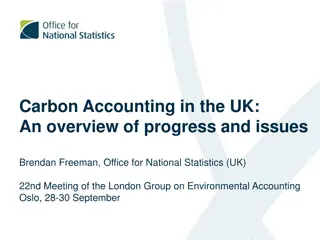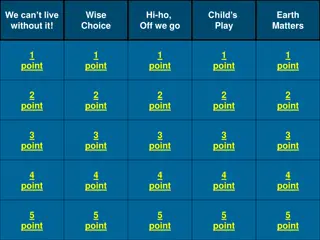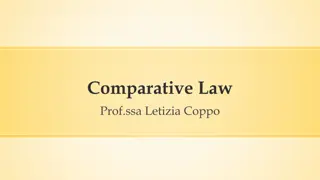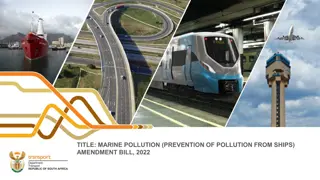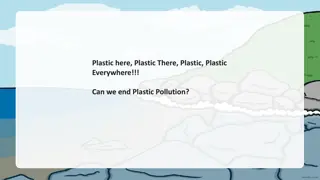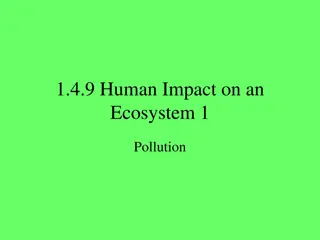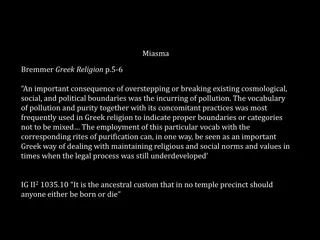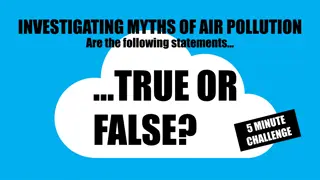Federal Carbon Pollution Pricing System in Canada
Canadian Federation of Agriculture addressed climate change and economic growth by implementing a federal carbon pollution pricing system, focusing on agriculture. The system, part of the Pan-Canadian Framework, includes a federal backstop and provincial/territorial systems. Key milestones, such as the announcement in Oct 2016 and the Greenhouse Gas Pollution Pricing Act in May 2018, have led to the implementation of regulatory charges on fossil fuels and a performance-based pricing system for industrial facilities.
Download Presentation

Please find below an Image/Link to download the presentation.
The content on the website is provided AS IS for your information and personal use only. It may not be sold, licensed, or shared on other websites without obtaining consent from the author. Download presentation by click this link. If you encounter any issues during the download, it is possible that the publisher has removed the file from their server.
E N D
Presentation Transcript
Federal Carbon Pollution Pricing System with focus on agriculture Canadian Federation of Agriculture AGM February 27, 2019 Wearable technology, developed with funding from the NSERC Discovery Grants program Source: Western University 1
Addressing climate change and growing the economy Carbon pricing is one of the four pillars of the Pan-Canadian Framework. Provinces and territories had the flexibility to develop their own carbon pollution pricing systems meeting stringency criteria [the federal benchmark]. The federal government committed to implement, in whole or in part, a system in jurisdictions that request it or that do not have a system that meets the federal benchmark [the federal backstop]. The Pan-Canadian Framework includes more than fifty other measures to reduce greenhouse gas emissions, foster adaptation and resilience to a changing climate, enhance the development and adoption of clean technology solutions. 2
Key milestones Oct 2016 Pan-Canadian Approach to Pricing Carbon Pollution announced by PM Dec 2016 Pan-Canadian Framework on Clean Growth and Climate Change signed by First Ministers May 2017 Technical Paper on the proposed design of the federal carbon pricing backstop released for comment Letters sent confirming Sept. 1 timeline for PT carbon pricing plans Dec 2017 Draft Legislative Proposals and proposed regulatory framework for large industries released for comment Jan 2018 Compliance options paper released for public comment May 2018 Greenhouse Gas Pollution Pricing Act received Royal Assent Jun 2018 PM announces where the federal system will apply based on assessment against the federal benchmark Oct 2018 Proposal for OBPS regulations released for comment Dec 2018 Federal OBPS requirements start to apply in backstop provinces (July 1, 2019 in NU, YK) Jan 2019 Fuel charge comes into force (July 1, 2019 in NU, YK) Apr 2019 3
Carbon pollution pricing systems in Canada Federal backstop applies in full Provincial/Territorial system applies Federal backstop applies in part 4
The federal carbon pollution pricing system Under the Greenhouse Gas Pollution Pricing Act, adopted on June 21, 2018, the backstop has two parts: 1. Regulatory charge on fossil fuels will apply on April 1, 2019 in backstop provinces (July 1, 2019 in NU, YK). o Generally payable by fuel producers or distributors o $20 per tonne of carbon dioxide equivalent (CO2e) in 2019, rising by $10 per year to $50 per tonne CO2e in 2022. 2. Performance-based pricing system for industrial facilities (the Output-Based Pricing System or OBPS) requirements began on January 1, 2019 in backstop provinces (July 1, 2019 in NU, YK). o Designed to maintain competitiveness of emissions intensive, trade exposed industrial facilities. o Instead of paying the fuel charge on fuels that they purchase, facilities will pay the carbon pollution price on the portion of their emissions above a greenhouse gas (GHG) emission limit; enables emissions trading, including eligible offset credits from provincial systems. o Applies to facilities with emissions of 50 kt and above in covered sectors, with the option to apply for voluntary participation for facilities emitting 10 kt or more in emissions intensive, trade exposed sectors. 5
Breakdown of Canadas Emissions by Sector Agriculture contributes 10.2 % of Canada s total greenhouse gas emissions. Agriculture emissions are projected to be 75Mt in 2030, 3 Mt above 2016 levels. Breakdown of Canada's Emissions by Sector, 2016 (in Mt of CO2e) Electricity 79 Transportation 173 Oil and gas 183 Light manufacturing, construction & forest resources 20 Heavy Industry 75 Buildings 81 Agriculture 72 Coal production 2 Waste 19 Source: ECCC, 2018, National Inventory Report 1990-2016: Greenhouse Gas Sources and Sinks in Canada, Canada s submission to the United Nations Framework Convention on Climate Change, Table A10-2. 6
Most greenhouse gases generated by the agriculture sector will not be subject to carbon pollution pricing Greenhouse gas emissions from biological sources are not priced. Biological emissions from crop and animal production contributed to 83 % of emissions from agriculture in Canada. Canada s Greenhouse Gas Emissions from Agriculture in 2016 (in Mt CO2e) 80 70 60 Animal Production 37 Mt Targeted relief from the fuel charge The federal fuel charge does not apply to gasoline and light fuel oil (e.g., diesel) used in tractors, trucks and other farm machinery for the purpose of farming. 50 40 30 Crop Production 23 Mt 20 This approach is consistent with currently implemented carbon pollution pricing systems in British Columbia and Alberta. 10 On-Farm Fuel Use 12 Mt 0 Source: Canada National Inventory Report 1990-2016 part 3, 2018, table A10-2. 7
Re. Relief from the fuel charge for farmers provided under the federal carbon pollution pricing system The Greenhouse Gas Pollution Pricing Act provides that a registered distributor can generally deliver, without the fuel charge applying, gasoline or light fuel oil (e.g., diesel) to a farmer at a farm if the fuel is for use of farming activities. Farmers do not need to register. The relief is provided upfront through the use of exemption certificates, when certain conditions are met. The exemption certificate forms are now posted online (https://www.canada.ca/en/revenue-agency/services/tax/excise-taxes- duties-levies/fuel-charge.html) If you have question on this matter, you may contact: By email: fuelcharge@cra-arc.gc.ca By phone: 1-866-330-3304 8
Impact of carbon pollution pricing on farms where the federal system will apply direct impact This impact will depend on consumption patterns, farm size, operation type, weather over a given crop year and the carbon pollution pricing system that applies where a given farm is located. For an individual farm located in a jurisdiction where the federal fuel charge will apply, the impact can be assessed based on the rates provided in the table below. Federal Carbon Pollution Fuel Charge Rates for Fuels Commonly Used On Farms According to Statistics Canada, expenses for heating fuels contributed to about 1% of total farm operating expenses in Canada in 2017. Fuels $20/tonne of CO2e April 1, 2019 exempt1 exempt1 $50/tonne of CO2e April 1, 2022 exempt1 exempt1 Gasoline used on farm Light fuel oil (e.g., diesel) used on farm Marketable natural gas Propane Heavy fuel oil Partial relief from the fuel charge (80%) is proposed to apply to natural gas and propane used in commercial greenhouses. 0.0391 $/m3 0.0310 $/litre 0.0637 $/litre 0.0979 $/m3 0.0774 $/litre 0.1593 $/litre Source: Greenhouse Gas Pollution Pricing Act, Schedule 2. 1. Subject to certain conditions (e.g., fuel is used in eligible farming machinery). 9
Impact of carbon pollution pricing on farms where the federal backstop will apply indirect impact Electricity Facilities generating electricity from fossil fuels will be covered by the federal output-based pricing system, hence they will need to comply for only a portion of their emissions. The proposed fuel differentiated approach maintains a strong signal to move away from coal while reducing price impacts on business and households. Under the OBPS, facilities will have the option to comply by paying an excess emission charge, submitting federal OBPS surplus credits, submitting eligible offset credits, or any combination of the above. Road Hauling and Rail The impact on transportation cost will vary, notably depending on distance and fuel efficiency of vehicles. 10
Impact of carbon pollution pricing on farms where the federal backstop will apply indirect impact (continued) Fertilizers Fertilizers produced in backstop jurisdictions will be covered by output-based performance standards an approach that limits competitiveness risk. Fertilizer price index from 2002 to 2016, Saskatchewan and British Columbia 350 300 250 SK BC 200 150 100 50 2002 2004 2006 2008 2010 2012 2014 2016 Source: Statistics Canada, CANSIM table 328-0015, Farm Input Price Index 11
Approach to Carbon Pollution Pricing Proceeds Provinces with their own carbon pollution pricing systems can use proceeds to support their residents, grow the economy, and protect the environment (i.e., BC, Alberta, Quebec, NWT, Nova Scotia, Newfoundland and Labrador, PEI). Proceeds from the backstop will be returned directly to the governments of provinces and territories that requested the federal system (i.e., Yukon, Nunavut, PEI [OPBS]). In remaining provinces (i.e., Saskatchewan, Manitoba, Ontario, and New Brunswick): Direct fuel charge proceeds About 90% will be returned to residents through Climate Action Incentive payments. Residents in rural and remote areas will receive a 10% supplement. Residents may claim their payment when filing their tax returns and receive it as part of their tax assessment starting in early 2019. Remaining proceeds will support SMEs, colleges & universities, schools, hospitals, municipalities, non-profits, Indigenous communities. OBPS proceeds will be used to support future climate actions in the jurisdiction in which the proceeds are collected. 12
Potential for carbon offsets Environment and Climate Change Canada released a proposal for the OBPS regulations on December 20, 2018. This proposal includes the use of offset credits from existing provincial systems as a compliance option for facilities covered under the OBPS. The proposal is to establish a list of eligible existing programs and protocols to facilitate the use of offset credits from existing programs in the early years of OBPS implementation. Protocols for activities that occur across multiple jurisdictions and that are not covered by carbon pricing will be assessed first. ECCC thus proposes to prioritize agriculture, waste and forestry project types. The GGPPA allows for the potential future development of regulations to establish a federal offset system for projects that prevent greenhouse gas emissions or that remove greenhouse gases from the atmosphere. 13
Other government initiatives Under the current $3 billion policy framework, the Canadian Agricultural Partnership (CAP), the federal, provincial and territorial governments will continue to support various initiatives to help the sector. Aside from support provided through the CAP, the Government of Canada funds other programs to foster the research and adoption of innovative practices and technologies: AgriScience and AgriInnovate will help support resiliency and sustainability of the sector through science, research and adoption of innovative practices and technologies ($466 million) Agricultural Greenhouse Gases Program ($27 million) Agricultural Clean Technology Program ($25 million) 14




